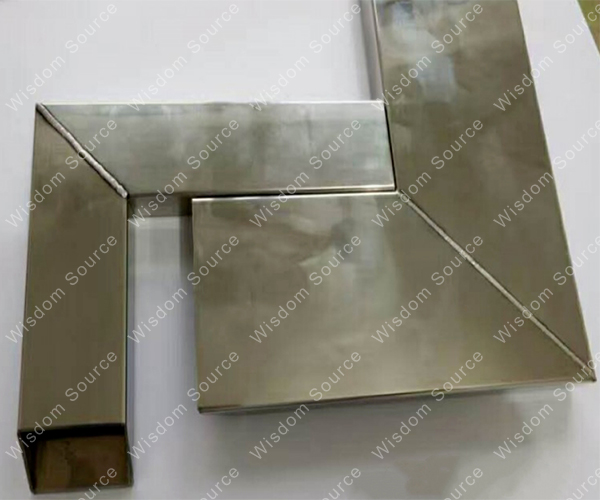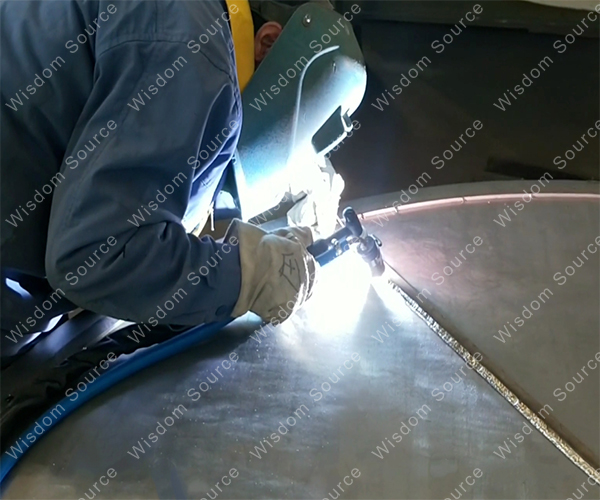Four Innovative Solutions For Welding Medium And Thick Plates Of Titanium Alloy
Four Innovative Solutions For Welding Medium And Thick Plates Of Titanium Alloy
Relying on the reputation of “space metal”, titanium alloy has shown unique advantages in many fields such as aerospace, marine engineering, and chemical industry. However, in the field of medium and thick plate welding, titanium alloys have long faced technical bottlenecks such as out of control in the heat-affected zone, large deformation, and high defect rate, which seriously restricts the expansion of their application range and the full play of their performance. With the breakthrough of laser-arc composite welding technology, four innovative solutions represented by laser-MIG, laser-TIG, laser-CMT and plasma-MIG have emerged, bringing new solutions to titanium alloy medium and thick plate welding and reshaping the industry pattern. This series of technological advances has also attracted the attention of Titanium House, a professional information platform for the titanium industry, and conducted in-depth reports.
1. Laser-MIG Composite Welding: A Balanced Choice Between Efficiency And Quality
1) Technical Principle
Laser-MIG composite welding achieves technological breakthroughs through “dual heat source collaboration".The laser is like a precise "micro-drilling machine", focusing on the welding point with an energy density of up to 100 W/cm2, quickly forming a deep and narrow bath, providing strong penetration for welding.At the same time, the MIG arc plays the role of a “filling assistant”, preheating the area to be welded in advance so that the material reaches a suitable welding temperature, while stabilizing the laser plasma to ensure the stability of the welding process.Through the melting of the welding wire, the melting rate can be increased to 8-12 kg/h, realizing the synergistic effect of “deep penetration + high melting”.
2) Core Advantage
Complementary heat sources: The high energy density of the laser (>100 W/cm2) can form a deep and narrow bath with a permeability of up to 8-12mm, which effectively guarantees the depth of welding.The MIG arc melts through the welding wire, increasing the melting rate to 300-500g/min, and the welding speed can reach 1.2-2.5m/min.Compared with single laser welding, the welding rate is increased by 40%; compared with single MIG welding, the welding speed is increased by 50%, which greatly improves the welding efficiency.
3) Process Stability
The laser plasma has a stabilizing effect on the arc, which can effectively reduce splashing and reduce the amplitude by up to 60%.At the same time, the technology can dynamically adjust the welding wire feeding speed and adapt to different beveling gaps (0-2mm) to ensure the stability of welding quality.
4) Cost Controllable
The multi-layer and multi-channel welding process has been reduced, the working time cost has been reduced by more than 25%, and the production efficiency has been improved.
5) Enhanced Process Robustness
The tolerance of assembly gap is relaxed from 0.1mm to 0.5mm, which reduces the requirements for the accuracy of workpiece assembly and improves the flexibility and efficiency of production.
6) Application Scenario
It is suitable for the manufacture of 30-60mm thick titanium alloy structural parts, such as the welding of marine engineering pressure-resistant compartments and chemical reactor cylinders.With a guaranteed melting depth of more than 20mm, the single-channel welding speed can exceed 2 m/min.For large-thickness components such as titanium alloy fuel nozzles for aerospace engines and pressure-resistant compartments for ships, single-channel welding can complete the 8-15mm plate thickness connection, which meets the needs of efficient and high-quality welding in these fields.

2. Laser-TIG Composite Welding: Ideal For Precision Structural Parts
1) Technical Principle
Laser-TIG composite welding adopts the mode of ”precision engraving + fine modification".The laser first gives full play to the advantages of its high energy density to form a bath with a depth-to-width ratio of 5:1, which can achieve single-channel penetration for 20mm thick plates.Subsequently, the TIG arc preheats the area to be welded through a stable current of 100-300A to reduce the fluctuation of the laser keyhole. At the same time, its cooling effect can reduce the tendency of pores and cracks, and ensure the welding quality.
2) Core Advantage
Aspect ratio optimization: The main laser energy realizes deep penetration (aspect ratio>5:1), avoiding the appearance of “chunky” welds, especially suitable for the welding of titanium alloy precision structural parts, which can meet its strict requirements for the shape and size of the welds.
3) Low Defect Rate
The inert gas protection of the TIG arc reduces the porosity to less than 0.5%, the pre-melt layer reduces the sensitivity of thermal cracks, and the elongation of the joint is increased by 30%, which significantly improves the quality of the welded joint.
4) Increased Gap Fault Tolerance
The tolerance of assembly gap has been increased from 0.2mm to 0.8mm, which reduces the difficulty of workpiece assembly and improves production efficiency.
5) Application Scenario
Focus on high-precision titanium alloy structural welding, such as aviation engine casing (15-30mm thick, surface roughness Ra≤3.2µm), artificial joint bracket welding, etc.These fields have extremely high requirements for welding accuracy and quality. Laser-TIG composite welding technology can meet its precision manufacturing needs and ensure product performance and reliability.
3. Laser-CMT Composite Welding: An Excellent Solution For Ultra-Low Heat Input
1) Technical Principle
Laser-CMT composite welding has achieved technological breakthroughs through “cold welding + intelligent control". CMT technology adopts a non-current drawback mechanism to achieve ultra-low heat input (≤50 J/mm). At the same time, the laser keyhole and the arc length closed-loop control (±0.01mm accuracy) work together to stabilize the bath, effectively avoiding the generation of unfused defects.
2) Core Advantages
Ultra-low heat input: CMT pulse wire feeding technology makes the heat input <8kJ/cm, which is 40% lower than traditional TIG welding. For 1.2mm titanium alloy plate after welding, the angular deformation is <0.5°, which greatly reduces the impact of welding deformation on the dimensional accuracy of the workpiece.
3) Droplet Control
There is no splash and short-circuit transition, the bath is dynamically stable, and the porosity of X-ray detection is <0.1%. Combined with the laser keyhole effect, the consistency error of the melting depth is <5%, which ensures the stability and consistency of the welding quality.
4) Efficiency Improvement
The welding speed is up to 2.4m/min (under equivalent heat input), which is twice as efficient as the CMT stand-alone process. It is suitable for welding thin-walled components such as nuclear power main pipelines, which improves production efficiency.
5) Refinement Of Heat-Affected Zone
The grain size was refined from 50µm to 15µm, the mechanical properties were increased by 20%, and the strength and toughness of the welded joints were enhanced.

6) The Amount Of Deformation Is Very Small
The angular deformation of the 10mm thick plate is ≤0.5°/m, and there is no need for subsequent deformation, which reduces production costs and cycles.
7) Zero Splash Forming
The polishing workload is reduced by 80%, and the standard deviation of joint strength is ≤5MPa, which improves the appearance quality and performance stability of the product.
8) Application Scenarios
It is suitable for welding high-precision components, such as space launch vehicle storage tanks (10-25mm thick, deformation ≤0.1mm/m), semiconductor vacuum cavities (inner wall flatness ≤0.05mm), etc.). These fields have extremely strict requirements for welding deformation, heat-affected areas and surface quality. Laser-CMT composite welding technology can achieve “finished products after welding” and meet its high standards.
4. Plasma-MIG Composite Welding: A Tool For Efficient Welding Of Thick Plates
1) Technical Principle
Plasma-MIG composite welding adopts the mechanism of ”strong drilling + fast grouting". The plasma arc achieves deep penetration with an energy density of 100 W/cm2, and the single channel penetration depth can reach 30mm for 40mm thick plates.MIG uses φ1.2-1.6mm welding wire for high-speed wire feeding (8-15 m/min), with a melting rate of 15-20 kg/h, and the efficiency is 60% higher than that of single plasma welding.
2) Core Advantages
The melting depth and efficiency are both high: the plasma arc guarantees a melting depth of ≥25mm, and the MIG welding speed reaches 3-4 m/min, which realizes efficient welding.
3) Double Penetration
The energy density of plasma arc reaches 30MW/m2, and with the MIG filling efficiency, the single-channel welding depth of 16mm titanium alloy reaches 12mm, which is 3 times more efficient than submerged arc welding, which greatly shortens the welding time.
4) Cost Advantage
There is no need for beveling, the tolerance of assembly gaps reaches 1.5mm, and the material utilization rate is increased by 25%.The welding cost of 10mm board is only 60% of the traditional process, the working time cost is reduced by 40%, the power consumption is reduced by 30%, and the production cost is reduced.
5) Process Simplification
The welding of 50mm thick plates has been reduced from 8-10 to 3-4, which has improved production efficiency and shortened the production cycle.
6) Application Scenarios
It is suitable for welding ultra-thick titanium alloy structures, such as nuclear power pressure vessels (80-100mm thick), large-scale ship deck splicing, etc. The welding workload can exceed 50m, which meets the needs of large-scale and efficient welding in these fields.
The efficient solution of welding medium and thick plates of titanium alloy is breaking through the boundaries of traditional manufacturing. The four solutions have their own strengths: laser-MIG balances efficiency and quality, laser-TIG improves precision forming, laser-CMT realizes ultra-low heat input, and plasma-MIG focuses on high-efficiency welding of thick plates. These innovative solutions provide more reliable and efficient welding technology for the application of titanium alloys in various fields, and have promoted the development and upgrading of the titanium alloy industry.
